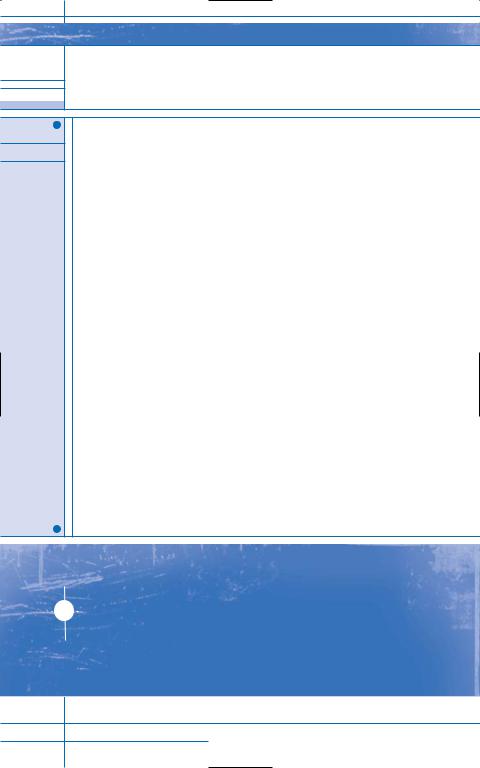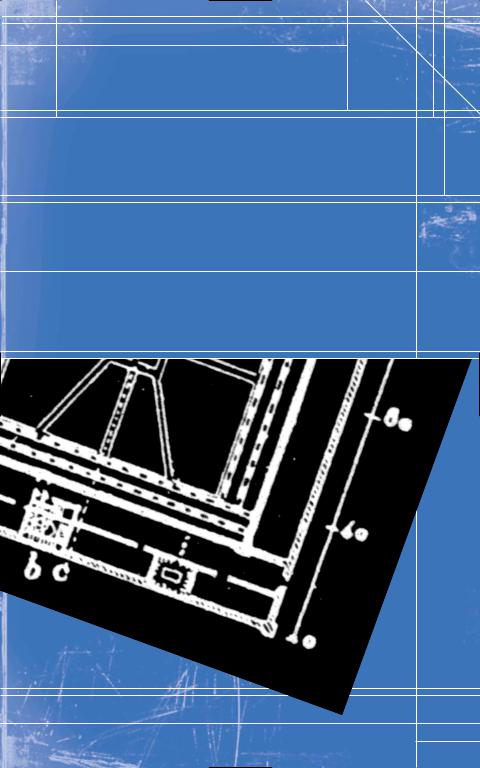
- •Table of Contents
- •Introduction
- •The 5 Dramatic Throughlines
- •The 6 Conflicts
- •The 21 Genres
- •The Replay
- •Fate
- •The Parallel
- •The Episodic
- •The Journey
- •Interactive
- •Metafiction
- •The Slice of Life
- •Introducing the 55 Dramatic Situations
- •Situations 1 & 2
- •Situations 3 & 4
- •Situations 5 & 6
- •Situations 7 & 8
- •Situations 15 & 16
- •Situations 17 & 18
- •Situations 43 & 44
- •Situations 45 & 46
- •Situations 47 & 48
- •Situations 49 & 50
- •Situations 51 & 52
- •Research

Situations 51&52
LOSS OF A LOVED ONE AND RESCUE OF A LOVED ONE
“The beauty of the world has two edges, one of laugh-
ter, one of anguish, cutting the heart asunder.”
–VIRGINIA WOOLF
Loss of a Loved One
Loss is the condition of being deprived or bereaved of something or someone.
This situation requires a Kinsman Slain, a Kinsman Spectator, and an Executioner.
This situation is all about mourning. A Loved One has died and the surviving family members are trying to come to terms with their loss. The Slaying may have come about in several different ways:
•A Kinsman Spectator may have witnessed the Slaying but was unable to do anything about it.
•A Kinsman Spectator may have helped to bring misfortune upon one’s people through secrecy and as a result many were slain.
•A Kinsman Spectator may have divined the death of a Loved One.
•A Kinsman Spectator learns about the death of a Loved One after it has happened.
His kin may seek revenge, but that is not the only focus of this situation. It is the feelings and reactions to losing the Love One that are the focus. The despair, grief, guilt, and helplessness make this dramatic.
How the kinsmen react is what this situation is about, especially if one of the kinsman witnessed the event. Things to consider:
•How do they handle the funeral?
•How do they handle hearing the news?
•What sort of problems does this bring them?
•Did the Kinsman Slain have a spouse and children?
•Will anyone seek revenge?
Situations 51 & 52 |
253 |

•Was it an accident?
•Do the kinsmen start to question God?
•Do the kinsmen try to understand and explore what death is?
•Are there any kinsmen who are glad the Kinsman Slain is dead?
THE KINSMAN SLAIN
The Kinsman Slain was someone who is usually deeply loved by his fellow kinsman, at least most of them. This is what makes it so tragic, because he may have:
•done good deeds
•helped out kinsmen when they needed him
•been a mentor to younger kinsmen, teaching them about life
•tried to live a good decent life, keeping to himself
•done some foolish things in his life but was still very charming
•had some endearing quality about him that others are drawn to
KINSMAN SPECTATOR
There may or may not be a Kinsman Spectator of the Slaying. If there is, most of the situation will probably be about how this Kinsman Spectator handles what she saw. She may:
•be paralyzed with fear and terror
•be numb and unable to face what happened
•go into shock
•change her whole personality
•lose faith in people and those that are supposed to be there to protect, causing her to become ever vigilant
•give up things she once held dear
THE EXECUTIONER
The Executioner is usually not the main focus of the story, as the main focus is on the loss of the Kinsman Slain. There is usually not a great deal of mystery surrounding the Kinsman’s death. The cause of death is usually pretty clear. Once the Slaying takes place, the Executioner doesn’t play much of a role in the story. In fact, the Slaying itself may never be seen. Perhaps the story opens with a mother getting a phone call about her son’s death and we later hear from the Kinsman Spectator.
The Executioner may be an inanimate object such as drugs, a vehicle, or a rusty nail that infected the Kinsman.
The Executioner may even be the Kinsman Spectator if he is the
254 Story Structure Architect

one to bring misfortune to his kinsmen. Perhaps he is behind the wheel of the car that crashes, Slaying his fellow Kinsman.
Whether Loss of a Loved One is used as plot, subplot, or incident, the elements of the beginning, middle, and end are the same:
BEGINNING: A Kinsman is slain.
•Will the Executioner be shown?
•Will the Executioner be a person or an object?
•Will another Kinsman be there to witness it?
•Is the Slaying an accident? Or premeditated?
•Why is the Kinsman Slain? Did he do something wrong?
•How do other characters feel about it?
•Did he have any surviving children?
•Was he supposed to achieve greatness? Help a large group of people? Was he important?
MIDDLE: The Kinsman reacts to the Slaying.
•Will he seek revenge?
•Will he try to fill the Kinsman Slain’s shoes? Carry on where he left off?
•Will he put himself in jeopardy now?
•Will he act differently? Lose his mind on some level?
•What will the rest of the family do? How will they deal with this? Are they afraid for the Kinsman?
END: The Kinsman comes to terms with the Slaying and gets on with life.
•Did he seek revenge? Was he successful?
•Has he found a way to let the pain go and get on with his life? How?
•Does he have to face other family members? Are they upset with him for moving on?
•How has his life changed?
•What will he do now?
•Is there anyone he can help who might be like the Kinsman Slain?
“It is not because things are difficult that we do not dare; it is because we do not dare that they are difficult.”
–LUCIUS ANNAEUS SENECA
Situations 51 & 52 |
255 |

Rescue of a Loved One
To rescue means to set free from danger or imprisonment.
In this situation the Kinsman Spectator becomes the Rescuing Kinsman. Whereas in the previous situation the Kinsman Spectator was helpless, in this situation she is able to pull herself together, gather her resources, and plan a rescue. Think of Finding Nemo and how
the father fish rescues his son.
She is willing to do whatever it takes because the Kinsman means that much to her. They have family ties, but their relationship goes deeper than that.
She may not know how strong and resourceful she is until she has to step up and help him. This situation may be just what she needed to pull her out of her shell and force her into seeing how great and strong she really is.
Whether Rescue of a Loved One is used as plot, subplot, or incident, the elements of the beginning, middle, and end are the same:
BEGINNING: A Kinsman is threatened and the Rescuing Kinsman witnesses it.
•Why doesn’t she jump in and rescue right now? What is the danger?
•Why does she want to rescue him? Is he her child?
•What does she stand to gain by rescuing?
•What is at stake?
•Where does the rescue have to take place? Does the place add more drama and make it harder to rescue?
•Do other characters want to help?
MIDDLE: The Rescuing Kinsman puts a plan together.
•Is she good at putting together plans? Or bad at it?
•Does she like to just jump in and do things even though the timing may be wrong?
•Will other characters help her?
•Is she in this alone?
•Does the Threatened Kinsman want her help?
•Is the rescue one of just giving money?
END: The Rescuing Kinsman rescues the Threatened Kinsman.
•How does the rescue take place?
•Are there any problems? What goes wrong?
256 Story Structure Architect

•Is she successful? Are there any sacrifices made?
•Is the Threatened Kinsman happy and grateful?
•How does the Rescuing Kinsman feel about herself now?
•What do other characters think?
•What will the Rescuing Kinsman do now?
EXAMPLES
While I Was Gone, SUE MILLER
LOSS OF A LOVED ONE AS SUBPLOT—When she was in her twenties, Jo Becker discovered the body of her murdered best friend. She spends the next thirty years trying to come to terms with what happened without letting it ruin her marriage and relationship with her daughters.
The Big Chill, LAWRENCE KASDAN
LOSS OF A LOVED ONE AS SUBPLOT—At the funeral of one of their friends, a group of people who attended college together reunite.
The Last of the Mohicans, JAMES FENIMORE COOPER
RESCUE OF A LOVED ONE AS PLOT —Three trappers protect a British Colonel’s daughter in the midst of the French and Indian War.
Finding Nemo,
ANDREW STANTON AND LEE UNKRICH
RESCUE OF A LOVED ONE AS PLOT—Marlin is a widower who takes care of his only son Nemo. On Nemo’s first day of school he’s captured by a scuba diver and taken to live in a dentist office’s fish tank. Marlin sets off to find Nemo at all costs.
Situations 51 & 52 |
257 |

Situations 53&54
ODD COUPLE AND FISH OUT OF WATER
“Chaos and Order are not enemies, only opposites.”
–RICHARD GARRIOTT
Odd Couple
Odd means deviating from what is ordinary, usual, or expected.
This situation requires a Hero, a close Opposite Hero, and an Event that brings them together.
Two characters that are completely different in almost every way are forced to work together to achieve a common goal. Their differing styles and opinions cause much of the obstacles they face in the story and place their goal in jeopardy until they learn to work together and accept the other’s way of being and working. Think about:
•the two buddy cops who can’t stand working together but are forced to do so by the captain; one is soft, caring, and educated; the other is hard, tough, and street-smart
•the tough outdoorsman and city girl who fall in love and try to make it work
•the neat freak who has to live with the sloppy dirt-a-holic after his divorce (The Odd Couple television series)
These characters can differ in many ways, such as:
•occupation
•history and upbringing
•education
•philosophy
•hobbies
•morals
•goals and aspirations
•ways of living
•social interactions with others
258 Story Structure Architect

•class or social standing
•money and culture
THE HERO
The Hero likes things done a certain way. Whatever the focus of the story is, the Hero knows a definite way to go about reaching his goal and he doesn’t want to deviate from his way at all. He may not know any other way and therefore feels uncomfortable if someone forces him to do things another way. His pride could be at stake as well as his self-esteem if he has to admit he doesn’t know how to do it another way.
He takes a “my way or the highway” approach to the job at hand, but that won’t work. If he wants to reach the goal he will have to learn to let go a little and work in a team.
He may genuinely feel his way is the right way and not want to change because he believes his way will save the day. He will then want to convince or change his partner, which only makes matters worse.
OPPOSITE HERO
The Opposite Hero feels the exact same way as the Hero. She knows her way is the right way and she wants to convince or change the Hero. She will also have to learn to work in a team to get the job done.
Both the Hero and the Opposite Hero may get frustrated and try to use guilt, manipulation, or any other psychological game to change the other, but in the end it doesn’t work too well and may only be temporary. Sooner or later, the one who tried to change will get very angry and lash out.
THE EVENT
The Event is something that happens that forces the two Heroes to be together in some way. There must be a compelling reason for both Heroes to be involved with this event so neither Hero can just walk away. Something about this event connects them—they have the same boss, live in the same apartment building, know the same man who needs help—anything at all can connect them.
Perhaps they are forced to work together on a project or they will be fired. Or think of As Good As It Gets and how the artistic gay man and his obnoxious, obsessive-compulsive, older neighbor are forced to interact and help each other out. Or think of the television show The Odd Couple and how Oscar is forced to take in his friend when his wife kicks him out on the street.
Situations 53 & 54 |
259 |

Whether Odd Couple is used as plot, subplot, or incident, the elements of the beginning, middle, and end are the same:
•Are both equally unhappy with the situation? Or is one eager to work with the other at first?
•In what way are they opposites?
•Is either willing to try to change at this point? Or do they clash right away?
•Will anyone else get involved to try to help them?
•What Event makes them work together? It can’t be easy for them to just walk away from each other.
MIDDLE: The Hero and Opposite Hero create their own obstacles toward reaching their goal.
•How will you use their opposing force against them? How will you turn it into Conflict that puts the goal in jeopardy?
•Will they find a way to work together or fight the whole time?
•Can an intermediary help them work things out?
•Do any other characters come to help? Are they like the Hero or the Opposite Hero?
END: The Hero and Opposite Hero manage to work together for once and reach the goal.
•Did one of them concede and do it the other one’s way? Or did they both work together?
•What brought about this change?
•Did one character grow from being around the other? Did both of them grow?
•What did they learn from this?
•Would they work together again?
“The truth is that our finest moments are most likely to occur when we are feeling deeply uncomfortable, unhappy, or unfulfilled. For it is only in such moments, propelled by our discomfort, that we are likely to step out of our ruts and start searching for different ways or truer answers.”
–M.SCOTT PECK
260 Story Structure Architect

Fish Out of Water
A Fish Out of Water is a misfit who is unable to adjust to his environment or circumstances or is considered to be disturbingly different from others.
In this situation, the Hero is in conflict with an opposing Situation. She doesn’t fit in where she is pushed to go, or at least feels that way. This could either be a simple issue of self-esteem for her, with everyone else thinking she fits in just fine, or she really could be out of her element. Why should she fit in? She should be allowed to be herself.
Whatever the reason, the Hero is in a situation that feels extremely uncomfortable for her. She may not know how to act, what to say, how to dress, who to talk to, and what is or is not acceptable where she is.
Her secondary goal may be to get out of the situation as quickly as possible, but she probably has to be there to get something that will lead her to her goal. She could be seeking information or trying to make a contact. Something very important awaits her within the situation or she wouldn’t be going there at all.
She could snap under the pressure depending upon her personality and defensiveness, especially if someone makes fun of her.
Whether Fish Out of Water is used as plot, subplot, or incident, the elements of the beginning, middle, and end are the same:
BEGINNING: The Hero finds out she has to go somewhere she absolutely does not want to go.
•What compels her to go? Will it bring her closer to her goal?
•Why doesn’t she feel like she’ll fit in?
•Can she bring anyone with her for support?
•Will others make fun of her?
•How does she get herself excited to go?
MIDDLE: The Hero goes and feels completely out of place.
•Where does the Event take place? Can you change the place to make it more awkward for her?
•Is she able to fit in a little bit?
•Is it funny to see her in this situation?
•Does she get in little jabs at people without them realizing she is putting them down?
Situations 53 & 54 |
261 |

•Does she blow her cover?
•Will she be able to go back?
END: The Hero gets through the Event and finds the information that leads her to her goal.
•Does she receive help to get to her goal? Or does she do it all by herself?
•Does she embrace her differences?
•Does she have a newfound respect for the place or people she didn’t fit in with?
•How has she changed from this?
•Are there any other places she wants to go now to see if she can fit in?
•Has she gotten a sense of humor from going through this?
EXAMPLES
Romancing the Stone, ROBERT ZEMECKIS
ODD COUPLE AS SUBPLOT—A girl from the big city meets a reckless soldier of fortune while lost in the jungle.
48 Hrs., WALTER HILL
ODD COUPLE AS SUBPLOT—A hard-nosed cop reluctantly teams up with a wisecracking criminal temporarily paroled to him in order to track down a killer.
Miss Congeniality, DONALD PETRIE
FISH OUT OF WATER AS PLOT—A tomboyish FBI agent goes undercover in the Miss United States beauty pageant to prevent a group from bombing the event.
Coyote Ugly, DAVID MCNALLY
FISH OUT OF WATER AS INCIDENT—A shy, small-town girl in her early twenties goes to New York City to pursue a dream of becoming a songwriter. She gets a job at a nightclub called Coyote Ugly where she struggles to fit in.
262 Story Structure Architect

Situation 55
BLANK SITUATION TEMPLATE
“There is no doubt that creativity is the most important human resource of all. Without creativity, there would be no progress, and we would be forever repeating the same patterns.”
–EDWARD DE BONO
Blank Situation Template
The above quote says it all about this situation. I want you to have the freedom to design your own situations if your story calls for it. While using situations that have been done and are known to work is a great way to write, there should always be some room for personal creativity.
Perhaps there are situations found only in certain cultures or certain fields of expertise. It would be impossible to include them all here, so I’ve come up with a blank situation template you can use to help flesh out a new situation if you need to.
SITUATION TEMPLATE
•What is your reasoning for creating this situation?
•Are you absolutely sure you can’t use one of the situations already outlined?
•Will this situation be a plot, subplot, or incident?
•What is at stake for the hero? Or what is the hero’s dilemma at the beginning of the situation? What needs to be solved? Or is this a Slice of Life situation? If so, what is the point of this situation? What do you want to convey?
•Can you piece together a beginning, middle, and end? (If you don’t want a beginning, middle, or end, you don’t need a situation. Just watch a film like Before Sunrise or Daughters of the Dust to get a feel of stories without the beginning, middle, and end structure.)
•Find the beginning: What does the hero want? What is his objective?
Situation 55 |
263 |

•Find the middle: What does the hero do to get it?
•Find the end: How does the hero get it?
•What do other characters think about this situation and what the hero wants? Will anyone try to stop the hero?
•Is there a clear-cut antagonist? What does the antagonist want? Is the antagonist human? Or something intangible?
•What type of obstacles can you put in the hero’s way? How many? Will they escalate as he gets closer to the goal?
•How does the hero change during this situation? Does this situation cause another situation to happen?
•Does the hero or reader learn from this situation? Or is it just a fun ride?
•Will you have a theme?
•Will a smaller character become the heroic character during this situation? Will characters switch places?
•Will a sidekick character come onto the scene to help the hero?
•Will the hero want to share the spotlight with someone else? (In some cultures it is not acceptable for one person to take all the credit for something. In America it is the achievement of the individual that matters, but in other countries it is the achievement of the whole of society or family that matters. They don’t want to stand out.)
•Could you use an antihero?
As you create, here is some food for thought:
“Sometimes the situation is only a problem because it is looked at in a certain way. Looked at in another way, the right course of action may be so obvious that the problem no longer exists.”
–EDWARD DE BONO
264 Story Structure Architect

Part 4 |
FINISHING TOUCHES
